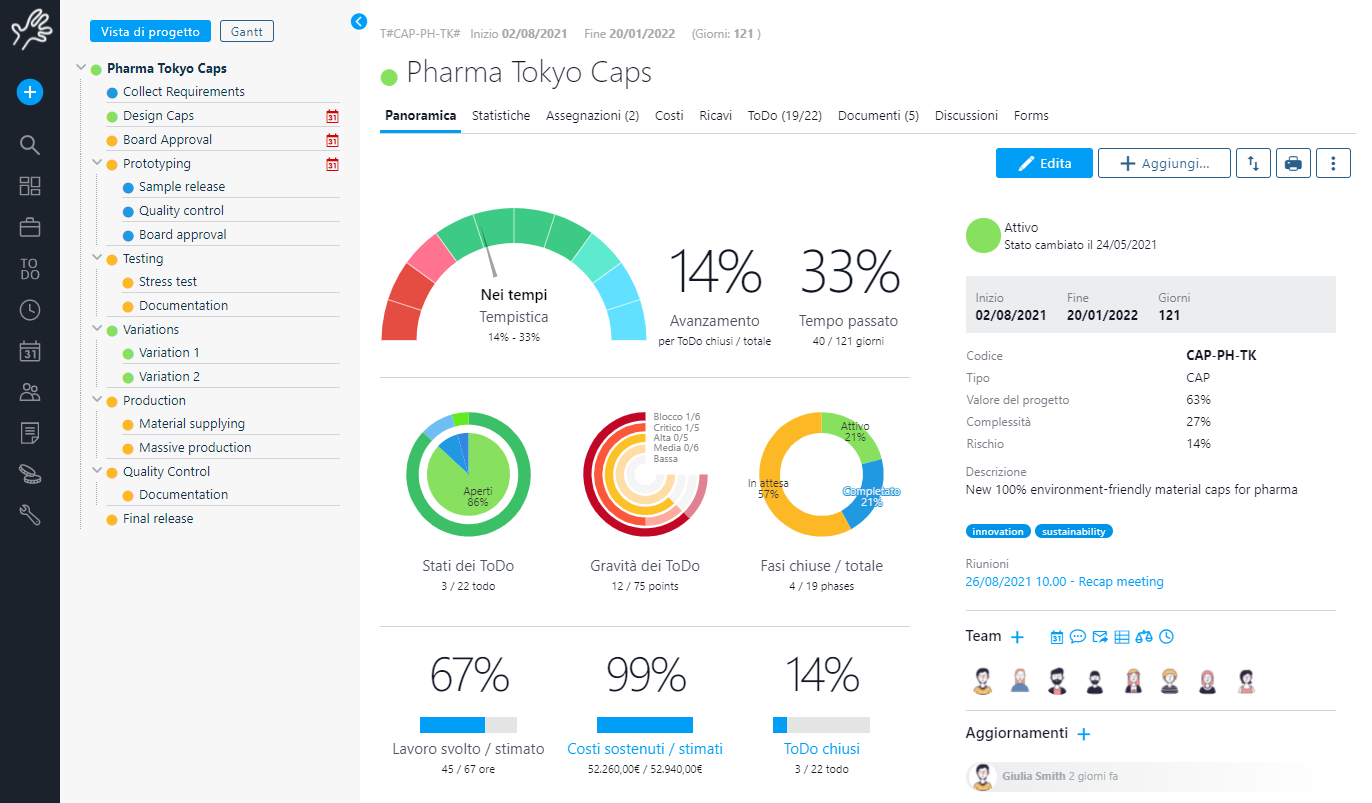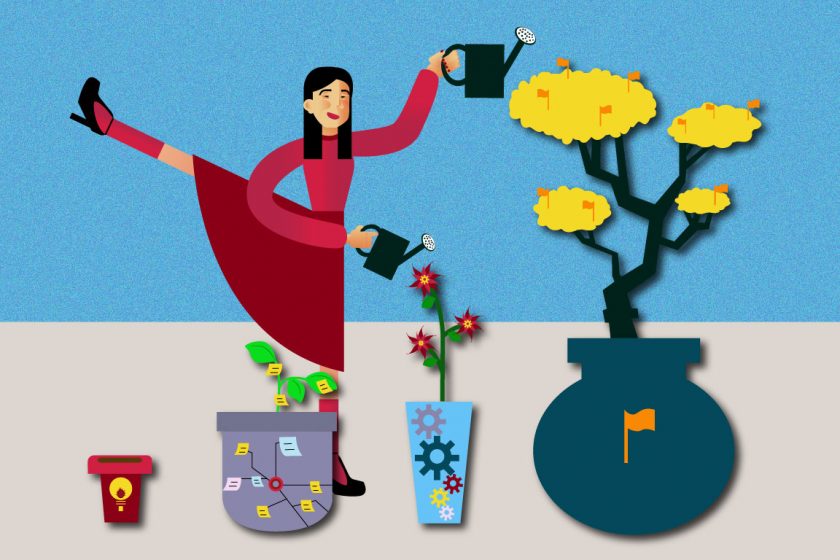The Project Life Cycle consists of four main phases in which the Project Manager and his team cooperate to achieve work together to achiev established objectives.
The four phases that mark the life of the project are: conception / start, planning, execution / implementation and closure.
Each project therefore has a beginning, a central period, a completion and a final phase (successful or not). All phases that we will analyze in this article constitute the so-called Project Life Cycle.
Obviously, those mentioned are only the main phases of the project, which means the starting point for a further subdivision in sub-phases, activities and tasks, increasingly basic and detailed, necessary for the development and allocation of work among the resources.
For each phase or lifecycle activity, the project manager must have two clear things in mind:
- The objectives of each project phase: based on company constraints ranging from quality to timing and costs;
- Products (derivable): every activity must lead to results that can be tangible goods or a documentation or specific services, etc.
But now we specifically enter the four main phases of the project life cycle.
CONTENT INDEX
Project Life Cycle: The initiation phase
During this first phase, the objective or “need” of the project is identified.
This can be, for example, the resolution of a business problem or the analysis and creation of a concrete opportunity.
An appropriate responce to the need can be documented in a business case with the recommended solution options.
A feasibility study is then conducted to verify if each option is in line with the objective and a final solution is determined.
The feasibility study asks questions about the feasibility of the project. Questions such as “can we do the project? Do we have the resources to do it?“.
Furthermore, a justification study phase of the project is also carried out, for example by answering the question “is the project necessary for this objective?“.
Once these analyzes have been carried out and the project is considered feasible and necessary, this is officially started and, in case it has not already been identified, a project manager is appointed.
The project team is then identified and involved, thus starting to take shape.
At this point we can then move on to the detailed planning phase.
If we use a good project management application, the initiation phase will be much easier and once fully operational, the software itself will answer the questions mentioned above, i.e. if we have the resources to do it, if it is functional to the objective and so on.
We plan ahead and monitor our progress, thus being able to identify the critical paths, anticipate project delays or interruptions before they happen and therefore improve workflow.

Twproject is a complete solution that offers all the tools the project manager needs in this phase. Using this platform you’ll have the possibility to create your project from the very beginning and add the different team members, specifying their roles.
Project Life Cycle: The planning phase
In this phase we start from the objective of the project and move on to develop it in as much detail as possible, planning the steps necessary to reach the final solution.
The individual tasks of the project are then identified, as well as the requirements that the resources must have and the strategy to follow.
A project plan is created that illustrates the activities, tasks and timelines.
The project manager coordinates the preparation of a project budget by providing cost estimates for labor, equipment and materials, if needed.
The budget is used to monitor and control the expenses incurred during the entire project phase.
Once the Project Manager has identified the work, prepared the strategy and the performance and estimated costs, the basic components of the planning process are complete.
It comes then the right time to identify and address any factor that may pose a threat to the success of the project. This part is called risk management.
Potential problems are identified, as well as the action that must be taken to avoid them, solve them or at least reduce their impact.
This is also a good time to identify all stakeholders and establish a communication plan that sets out the information needed to keep all the parties involved in the project informed.
Finally, the project manager will draw up a quality plan that includes the quality objectives, the control measures, also listing the criteria to be met obtain the acceptance of the client – customer that can be the company itself.
Arrived here, the project has been discussed and planned in detail, and is ready to run and move on to the next stage.
Twproject can also help you in this phase, in defining the activities through the drafting of the WBS and immediately following with the planning of the phases over time with an interactive Gantt editor:

Project Life Cycle: The execution phase
During the third phase, that of the implementation, the project plan is put into motion and the work is performed in concrete, following the steps structured in the planning phase.
It is important and fundamental to maintain control and communicate how – and when – necessary during this whole phase.
Progress is continuously monitored and appropriate changes are made and documented as variations with respect to the original plan.
Whatever project it is, a project manager usually spends most of the time at this stage.
During the execution of the project, people perform their tasks and progress information is exchanged through regular team meetings, so-called progress status meetings .
The project manager uses this information to maintain control over the project direction by comparing progress reports with the project plan, to measure the performance of activities and take corrective actions if necessary.
The main strategy should always be to bring the project back to its original course,that of the project plan drawn up in the previous phase. If this is not possible, the changes from the original plan must be recorded and the modified plan must be formalized.
During this step, project sponsors and all other stakeholders should be regularly informed about the progress of the work.
Each product result should be analyzed and accepted.
Once the results of the various steps have been produced and the client has accepted the final solution, the project is ready for closure.
Twproject helps you manage the execution phase, on two levels, for the project manager and for the team memebrs.
The project manager can constantly monitor the ongoing activities:

The team, on the other hand, will have a simple and extremely flexible ToDo management tool. ToDos can represent daily activities, tickets, bugs, ideas, organized in the form of a list or Kanban board.
Project Life Cycle: The closing phase
During this closing phase, the emphasis is placed on:
- the final results;
- the delivery of project documentation;
- the termination of supplier contracts;
- the release of project resources;
- the communication of the closure of the project to all the stakeholders.
The last remaining step is to conduct an analysis of what went well and what did not.
Through this type of analysis you gain experience and knowledge, are gained, factors that will help the project manager, and the team in general, for future projects.
Unfortunately, the closing phase is often underestimated and in many companies the project is delivered without further evaluation; it only matters if the project was a success or not.
In reality, it isn’t only important to conclude a project successfully, but also to be able to execute it in the way that was set in the original project plan.
There is no shortage of cases in which the objective has been achieved despite having experienced a phase of execution full of changes, delays and problems.
The closure phase also serves to analyze this, in order to avoid making the same mistakes in the future and not adequately assessing certain risks.
The four phases of this life cycle may vary according to the sector and the type of project, but in general they are valid in any area.
When a project manager follows Project Life Cycle taking into account all the factors of each individual phase, he will have already taken the first step towards success.
Tell us about your personal experience of success.
How can a project management software help you managing the life cycle?
As shown, good project management software can make a real difference in each of the 4 phases of the project life cycle, since it can:
- help you draft the WBS;
- guide you in planning and execution;
- monitor and verify the phases of a project with an interactive Gantt chart;
- check the correct balancing of the load on the resources.
That’s why a tool like Twproject is fundamental in the outcome of a project, since it has all the suitable tools for following each phase of a project’s life cycle, providing the project manager with a complete and constantly updated view.
Try it now for free! And afterwards, don’t forget to share your impressions and experience in managing the phases of a project with us.




